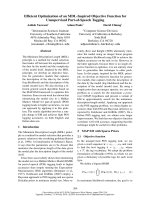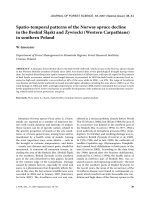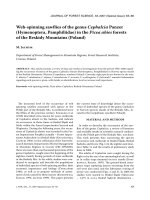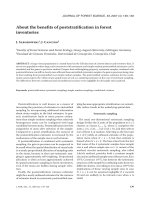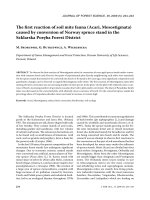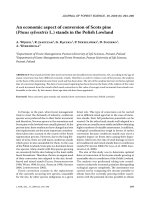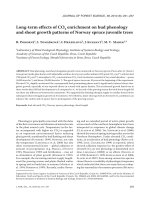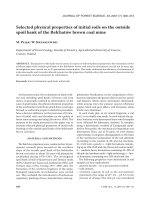Báo cáo lâm nghiệp: "Efficient method of micropropagation and in vitro rooting of teak (Tectona grandis L.) focusing on large-scale industrial plantations" pptx
Bạn đang xem bản rút gọn của tài liệu. Xem và tải ngay bản đầy đủ của tài liệu tại đây (854.15 KB, 6 trang )
Ann. For. Sci. 64 (2007) 73–78 73
c
INRA, EDP Sciences, 2007
DOI: 10.1051/forest:2006090
Original article
Efficient method of micropropagation and in vitro rooting of teak
(Tectona grandis L.) focusing on large-scale industrial plantations
Emilio M G
a
*
, Juwartina Ida R
a,b
, Eddo R
a
a
Dipartimento Produzione Vegetale, Università degli Studi della Tuscia, Via S. C. de Lellis, 1, Viterbo, 01100, Italy
b
Present address: Biotech Center, Agency for The Assessment and Application of Technology, Kawasan Puspiptek 630 Bld, Serpong, Indonesia
(Received 12 December 2005; accepted 2 March 2006)
Abstract – Multiple shoots of high quality were produced in vitro from nodal explants of Tectona grandis. An average of about 4 shoots/uninodal
explant was obtained within 4 weeks of culture on Murashige and Skoog’s (mMS) medium modified by 50% reduction in NH
4
NO
3
concentration,
supplemented with benzylaminopurine (1.5 mg L
−1
); indole-3-butyric acid (0.01 mg L
−1
) and gibberellic acid (0.1 mg L
−1
). The latter was applied both
in the medium and by soaking the nodal segments for 10 s. in a gibberellic acid solution of 100 mg L
−1
. Hundred percent of shoots rooted cultured on
modified MS medium containing IBA (0.5 mg L
−1
) and putrescine (160 mg L
−1
). Putrescine promoted both strong and highly ramified roots and fast
growing shoots during the rooting phase, conditioning the plantlets for a good survival and quality. Plantlets were transferred to jiffy pots for a short
acclimatization stage in greenhouse where they survived at 100%. This highly reproducible procedure can be adopted for large scale teak propagation.
plant growth regulator / putrescine / rooting / nodal explant / gibberellic acid
Résumé – Développement d’une méthode efficace de micropropagation et d’enracinement i n vitro du teak (Tectona grandis L.) pour une
production industrielle de plants. Des pousses multiples de haute qualité ont été produites in vitro à partir d’explants nodaux de Tectona grandis.
Une moyenne d’environ 4 pousses par explant uninodal a été obtenue dans un délai de 4 semaines de culture sur un milieu de Murashige et Skoog
modifié (mMS, NH
4
NO
3
réduit de moitié), complété avec la benzylaminopurine (BA, 1.5 mg L
−1
), l’acide indole-3-butyric (IBA, 0.01 mg L
−1
)et
l’acide gibbérélique (GA
3
,0.1mgL
−1
) dans le milieu et en imbibant les segments nodaux pendant 10 s dans la solution 100 mg L
−1
de GA
3
.Cent
pour cent d’enracinement in vitro des explants a été obtenu par la culture sur le même milieu de base mMS contenant IBA (0.5 mg L
−1
) et putrescine
(160 mg L
−1
). La présence de la putrescine a permis d’obtenir des racines fortes et ramifiées, des pousses à croissance rapide pendant l’enracinement,
donnant des plantes de qualité aptes à une bonne survie. Les plantes ont été endurcies et transférées dans des Jiffy pots pour une acclimatation brève en
conditions de serre ayant pour résultat 100% de survie. Ce procédé hautement reproductible peut être adapté à grande échelle dans la propagation de
teak du fait de l’efficacité du nombre de pousses obtenues (prolifération), de l’enracinement, de l’acclimatation et du bon développement des plantes.
régulateurs de croissance / putrescine / enracinement / explants nodaux / acide gibbérélique
1. INTRODUCTION
Teak (Tectona grandis L.), a leafy tree species, native to
India, Myanmar, Laos and Thailand, is one of the world’s pre-
mier hardwood timbers, attractive for its mellow colour, fine
grain and durability. It is highly sought after for shipbuilding
as well as interior and exterior luxury furnishings. The species
is reported to cover 27.5 millions ha as natural forests and
more than 3.3 millions ha as plantations in Asia. At present,
teak ranks among the top five tropical hardwood species in
terms of plantation area established worldwide [2, 15].
Establishment of new industrial forest plantations requires
a lot of time before meeting the high demand for this precious
timber. To enhance teak plantation development, the Indone-
sian government is making efforts to focus the research on im-
provement of the establishment of seed and clonal orchards to
make the elite planting materials available for mass multipli-
cation. In vitro propagation technique has become an efficient
* Corresponding author:
way for producing plants as uniform as possible on a large
scale and in a short time for the plantation industry [14, 19].
Teak is traditionally reproduced through seeds, but in most
cases, germination is difficult due to the hard seed coat, low
seed quality and late seed production. Poor germination rate
leading to a low production of seedlings further contributes to
the paucity of planting material [1, 25].
At present, even considering the very slow initial phase, in
vitro micropropagation should be considered as a commer-
cially feasible method for teak [10]. However, although nu-
merous authors have been experimenting to establish an ef-
ficient, reproducible and simple system for micropropagating
teak [11,16,25,27], it still remains problematic due to the poor
capacity of shoot proliferation, high susceptibility of shoots to
vitrification and browning and the low frequency of in vitro
rooting. None of the published protocols fully satisfies the re-
quirements for commercial application in spite of the progress
made on tissue culture of teak since the 1970s [8,13, 18].
In tissue culture, the propagated shoots of teak may
be rooted ex vitrum like conventional cuttings or in vitro.
Article published by EDP Sciences and available at or />74 E. Mendoza de Gyves et al.
However, in vitro rooting is often preferred because the plants
perform much better in terms of plant quality due to the ad-
vantage of possessing already roots during the acclimatization
phase [6]. In most of the tissue culture laboratories that pro-
duce teak plants in Indonesia and in the world, rooting is done
ex vitrum due to the low frequency of in vitro rooting, result-
ing in a too long procedure [3, 25, 27].
In this work we aimed to improve both the efficiency of
shoot proliferation and in vitro rooting and also to accelerate
the plant growth.
2. MATERIALS AND METHODS
2.1. Explant source and sterilization
Sixty shoot tips and single nodes of young twigs from a single
sexually mature teak plus plant from Central Java Indonesia were cut
off (at the end of may) from the explant source and were surface ster-
ilized with ethanol (70% v/v) for 60 s and then dipped in a 0.05%
mercuric chloride solution for 5−10 min. After rinsing three times
with sterile distilled water, explants were dipped in 5−10% commer-
cial bleaching solution containing 5% sodium hypochloride and a few
drops of Tween-80 for 5−10 min, followed by three rinses in sterile
distilled water.
2.2. Culture establishment
The nodal explants were then singly placed in test tubes (25 mm ×
150 mm) with basal MS [17] medium supplemented with 6-benzyl
amino purine (1.0 mg L
−1
) and adenine sulphate (20 mg L
−1
), su-
crose (3%) and solidified with 0.6% agar supplied by Duchefa Bio-
chemie (NL) to induce bud sprout and to select sterile shoots. Acti-
vated charcoal (Sigma, USA), 3 g L
−1
, was added to the medium to
reduce browning. Medium pH was adjusted to 5.8 before autoclav-
ing. After 30 days, the aseptic axillary shoots were transferred to a
fresh medium of the same composition for 3 subcultures to produce
a large number of shoots; then they were transferred to MS medium
(free of PGR’s) for 2 weeks in an attempt to eliminate any residual
prior to placing the explants on several proliferation media. The asep-
tic shoots were cut into single nodes with their respective 2 leaves and
placed, randomly distributed, into the different proliferation media. In
general, from each shoot 4−5 nodes were obtained.
2.3. Shoot multiplication
The culture media were: MS medium and modified MS (mMS)
medium, the latter containing half the concentration of NH
4
NO
3
;
both media contained 3% sucrose, 0.6% (w/v) agar (Duchefa), 0.8%
(w/v) pectin (from grape must) as anti-hyperhydricity agent, MS vi-
tamins and PGR’s as shown in Table I. The pH was adjusted to 5.8
before autoclaving. In some treatments, the explants (nodal segments)
were dipped in pre-filtered aqueous solution of GA
3
, for 10 s at
the concentration of 100 mg L
−1
, prior to being placed into the jars
(+GA
3
,Tab.I).
Four glass jars (580 mL) with glass cover were used per treat-
ment. Each jar contained 10 uninodal explants in 100 mL of medium.
The cultures were covered with a polyethylene film and incubated at
Tab l e I. Combinations of plant growth regulators (PGRs) used for
shoot proliferation of teak.
Media Plant growth regulator (mg L
−1
) Pulse treatment*
BAP AdS IBA GA
3
GA
3
mMS-A 1.5 – 0.01 0.1
mMS-A+GA
3
1.5 – 0.01 0.1 +
mMS-B 1.5 – 0.01 0.5
mMS-B+GA
3
1.5 – 0.01 0.5 +
MS-A 0.5 20.0 – –
MS-A+GA
3
0.5 20.0 – – +
MS-C 0.5 20.0 – 2.0
MS-C+GA
3
0.5 20.0 – 2.0 +
* Explants (nodal segments) were dipped in pre-filtered aqueous solution
of GA
3
at 100 mg L
−1
for 10 s.
approximately 24
◦
C, 16-h light (fluorescent lamps with photon lux
light intensity of 40 µmol m
−2
s
−1
). The percentage of explants ini-
tiating shoots, the number of shoots per explant, number of nodes
per shoot, shoot length and basal callus fresh weight were recorded
after 4 weeks of culture. Callus was removed from the shoots be-
fore weighing. The micropropagation cycle consisted of a monthly
subculture of nodal segments after removal of the new shoots onto
fresh medium. Data were collected three times at a two month in-
terval and subjected to one way analysis of variance (ANOVA). The
mean responses among the different treatments were compared ap-
plying the Student-Newman-Keuls (SNK) method using SigmaStat
for Windows Version 2.0 (Jandel Corporation, Erhrath, Germany). A
value of p < 0.05 was considered significant.
2.4. Rooting
Elongated shoots derived from nodal explants (grown on mMS-
A+GA
3
), were excised and their response to a range of rooting treat-
ments was determined. The rooting medium consisted of mMS plus
MS vitamins and 3% sucrose and solidified with 0.6% of agar. Indole-
3-butyric acid (IBA) was tested either alone (at 0, 0.5, 1, 1.5 mg L
−1
)
or in combination with putrescine (160 mg L
−1
). The cultures were
initially maintained for 6 days under dark and then exposed to light
and temperature as mentioned above. Eight shoots were inserted with
their basal endes into 100 mL of medium in a 580 mL glass jar. Each
treatment consisted of four jars, every one containing eight explants.
All experiments were repeated two times. The percentage of rooted
shoots, the total number of roots and root length for each rooted mi-
crocutting were evaluated after 4 weeks of culture on the rooting
medium.
The plantlets were transplanted to jiffy pots (round 8 × 8 cm) con-
taining a soil: vermiculite (1:1) mixture. Initially plantlets were cov-
ered with a polyethylene film, which was gradually eliminated in two
weeks time. Plants were transferred to pots and placed in a green-
house for completing their acclimatization (28 ± 2
◦
C RH 90%).
The data were subjected to one way analysis of variance (ANOVA)
and a pairwise multiple comparison procedure was applied using
the Student-Newman-Keuls (SNK) method to compare the mean re-
sponses among the different treatments. The SigmaStat program for
Windows, Version 2.0 (Jandel Corporation) was used. A value of
Method of micropropagation and in vitro rooting of teak 75
Figure 1. Effect of medium composition on average number of axillary shoots per node () and number of nodes () per shoot after one month
of culture. Values represent the means (40 replicates per treatment; repeated twice) and the same letters (within the same bars) indicate non
significant difference according to SNK test at P < 0.05. MS: Murashige and Skoog medium; mMS: modified Murashige and Skoog medium.
Figure 2. Effect of medium composition on average length of axillary shoots () and callus production at the base of the explants () after one
month of culture. Values represent the means (40 replicates per treatment; repeated twice) and the same letters (within the same bars) indicate
non significant difference according to SNK test at P < 0.05. MS: Murashige and Skoog medium; mMS: modified Murashige and Skoog
medium.
p < 0.05 was considered significant. To analyze the data on rooting
percentages, arcsin square root transformation was used.
3. RESULTS AND DISCUSSION
3.1. Explant responses
Approximately 80% of the node explants remained aseptic.
Three to four days after incubation on establishment medium,
the axillary buds started to burst. At least, one axillary shoot
developed per node, rarely two, however only one was able
to elongate. The process of teak culture establishment in this
experiment coincided with Devi et al. [7], who reported that
axillary shoots developed after 7−10 days and with Tiwari
et al. [25] who observed axillary shoots after 6 weeks on sev-
eral nodes.
3.2. Shoot proliferation
According to SNK test, among the media tested, modified
MS, without adenine sulphate, was superior to MS in terms
of average number of shoots per explant resulting in a statisti-
cally significant difference with 3.8 axillary shoots per explant
of MS-A+GA
3
medium versus 2.7 shoots in MS-A medium
supplemented with adenine sulphate (Fig. 1). GA
3
, both in the
medium or used by soaking the explants, was effective in full
MS medium, where it slightly increased number of nodes and
drastically increased shoot length (Figs. 1 and 2). Negative
76 E. Mendoza de Gyves et al.
Figure 3. Effect of different IBA concentrations (mg L
−1
) and the presence (+) or absence (–) of putrescine (160 mg L
−1
) on rooting percentage
of shoots obtained on mMS-A+GA
3
. Values represent the means (32 replicates per treatment; repeated twice) and the same letters indicate non
significant difference according to SNK test at P < 0.05.
correlation between shoot length and basal callus formation
was observed (Fig. 2). The callus production on the basal part
of the shoots was very frequent in this species, even in absence
of auxins [12, 20, 25]. Explants immersed in GA
3
showed re-
duced basal callus and longer shoots elongation on both media
(Fig. 2). The media: mMS-A and mMS –A + GA
3
presented
the best response with respect to a number of axillary shoots,
however the latter appeared more suitable for proliferation
since it showed the highest number of shoots per nodal seg-
ment (3.8) and relatively high number of nodes per shoot (4),
giving the highest multiplication factor reported for teak in the
literature. In addition, the medium mMS-A+GA
3
showed a
better length of shoots regarding the mMS-A and also with
a lighter basal callus, avoiding a further step for elongation of
shoots (Fig. 2). The shoots derived from this medium could be
rooted or cut into single node segments to continue the multi-
plication cycle (Figs. 5a and 5b).
Devi et al. [7] proposed a two step protocol in which they
obtained more than 200 shoots from a single explant in three
months. Our results showed that more than 800 shoots can be
obtained in a similar period of time, through the dissection
of the shoots into nodal explants avoiding a further subcul-
ture onto shoot elongation medium to prepare shoots for root-
ing phase. A protocol for micropropagation of teak using MS
basal medium supplemented with BAP and kinetin was sug-
gested by Goswami et al. [12]. In this protocol, an average of
3.7 shoots per explant in 8 weeks was produced, but the shoots
required further subculture onto elongation medium. In an at-
tempt to save time by avoiding an additional subculture step,
we used GA
3
in the proliferation medium to produce shoots
with longer internodes therefore, preparing the new shoots to
be used for rooting, and at the same time, the basal callus size
was reduced.
According to the literature, BAP has been the most com-
monly used in micropropagation of teak alone or with
kinetin [12, 13]. High concentration of BAP (5 mg L
−1
)was
applied for a few hours [25]. However, high concentrations of
BAP can be inhibitory to the growth of axillary bud sprouts
and can present some risks of unexpected abnormalities of
new shoots after this treatment such as vitrification [5]. On
the other hand, decreasing the cytokinin concentration gen-
erally reduces the multiplication rate. Ammonium is another
compound involved in vitrification [4]. We took steps to over-
come vitrification problems by modifying the MS medium (re-
ducing the ammonium quantity) and by adding pectin (from
grape must) [24,26] to reduce the water content in the medium
and by adding GA
3
since this was beneficial in olive [24]. Ac-
cording to general observations, these changes probably con-
tributed in the improvement of the culture quality reducing vi-
sual vitrification symptoms.
3.3. Rooting
After 4 weeks of culture, on the rooting medium, root-
ing took place only in the presence of auxin or putrescine.
IBA alone induced 30−50% rooting depending on its con-
centration, producing swollen and brittle roots. Putrescine
alone (160 mg L
−1
) promoted about 70% of rooting. Rooting
reached 100% when putrescine was combined with 0.5 mg L
−1
IBA (Fig. 3). Callus formation at the base of shoots increased
with increasing concentrations of IBA. The number of roots
per explant was low with the lowest IBA concentration, but in-
creased when IBA was combined with putrescine (Fig. 4). The
use of a low concentration of IBA is advisable since it does
not interfere with shoot growth, root elongation and keeps the
basal callus small, however, it induces only a few thin roots
without lateral ramifications. The combination of IBA with
putrescine resulted in vigorous roots with multilateral ramifi-
cations. Roots emerged at the base of shoots after 2 weeks. An
additional 2 weeks on this medium increased the number of
roots and promoted shoot elongation (Figs. 5c and 5d). Plant
Method of micropropagation and in vitro rooting of teak 77
Figure 4. Effect of different IBA concentrations (mg L
−1
) and the presence (+) or absence (–) of putrescine (160 mg L
−1
) on number of roots per
explant () and root length () after one month of incubation of shoots obtained on mMS-A+GA
3
. Values represent the means (32 replicates
per treatment; repeated twice) and same letters within the same colour of bars indicate non significant difference according to SNK test at
P < 0.05.
Figure 5. Micropropagation, in vitro rooting and acclimatization of teak: (a) multiple shoots in proliferation developed on modified MS
medium; (b) shoot proliferation from explants dipped for 10 s in GA
3
solution before culturing on medium; (c) effect of putrescine on root
ramification; (d) effect of different treatments on rooting after four weeks; (e) comparison between shoots rooted in vitro with IBA alone or
with putrescine (+ Put). Note a better growth of the plantlet rooted in presence of putrescine.
acclimatization after rooting on IBA + putrescine was 100%
successful, the plants had a good root system and no morpho-
logical abnormalities. The growth was higher in plants when
rooted with IBA combined with putrescine (Fig. 5e).
The application of exogenous polyamines to increase root-
ing and to improve root quality, was first demonstrated in
olive. When the polyamines were combined with auxins, it
promoted early rooting and increased the final rooting percent-
age and the number of roots per explant [21, 22]. Putrescine
is involved in root induction by increasing the activity of to-
tal peroxidases at the base of explants and promotes rapid
root growth and increases rooting frequency [23]. The posi-
tive effect of polyamines has been correlated to the low en-
dogenous level of polyamines found in olive shoots. In species
with high endogenous polyamine levels they had no benefi-
cial effect [22]. Perhaps teak contains low concentration of
78 E. Mendoza de Gyves et al.
polyamines, as does olive, and requires a reduction of endoge-
nous auxins during the root induction phase. This may occur
by H
2
O
2
freeing from polyamine catabolism, which is well
known to increase peroxidase activity reducing IAA in the in-
duction phase [23]. Putrescine not only induces an increase in
rooting percentage itself, but it requires a low concentration
of auxin for improving root quality, avoiding bud dormancy
caused normally by high concentration of auxins used during
the rooting phase. The absence of bud dormancy is essential
for acclimatization and subsequent shoot development.
Gangopadhyay et al. [9] carried out rooting in a liquid
medium supplemented with IBA and IAA, but the percentage
of the survival of plants after transplantation was relatively low
(77%), and the number of roots per plant has only 1.2 ± 0.2.
In alternative to in vitro rooting, ex vitrum rooting of teak
has been also proposed but survival of plantlets did not ex-
ceed 77% [25]. Our results offer better performance in terms
of rooting percentage (100%), plant survival (100%) and rapid
growth.
4. CONCLUSIONS
This study provides an efficient in vitro propagation method
which could be commercially feasible for teak, by providing
a protocol for producing genetically uniform plants from se-
lected genotypes. This work showed the highest number of
micropropagated shoots reported for teak, up to now, in the
literature and in a relative short period of time, producing
about 4 shoots with 4 nodes within 4 weeks. Particular em-
phasis should be done to the use of putrescine, which in com-
bination with low concentration of auxin, in rooting medium,
was essential in stimulating high rooting percentage with high
quality of roots, resulting in fast growing plantlets during ac-
climatization phase, reaching 100% of plant survival. Some
steps were important for improving quality of shoots both dur-
ing proliferation and rooting phases, aimed at reducing vitri-
fication problems and aimed at improving shoot length and
rooting percentage, by modifying the medium composition in
terms of salt balance, type of gelling agent, by adding pectin
of must wine, hormones and method of their administration,
resulting in a reduction of the process time from the usual
4−5 months reported in the literature to less than 3 months
including the greenhouse acclimatization period.
REFERENCES
[1] Bonal D., Monteuuis O., Ex vitro survival, rooting and initial de-
velopment of in vitro rooted vs. unrooted microshoots from juve-
nile and mature Tectona grandis genotypes, Silvae Genet. 46 (1997)
301−306.
[2] Dah U.S., Baw U.S., Regional teak marketing and trade,
Proceedings of third regional seminar on teak, Indonesia, 2001,
pp. 1–14.
[3] Castro R.D., Diaz G.J., Linero J.C., In vitro clonal propagation of
elite trees of teak (Tectona grandis L.), Rev. Colombiana Biotec. 4
(2003) 49−53.
[4] Daguin F., Letouze R., Ammonium-induced vitrification in cultured
tissues, Physiol. Plant. 66 (1986) 94−98.
[5] Debergh P.C., Effects of agar brand and concentration on the tissue
culture medium, Physiol. Plant. 59 (1983) 270–276.
[6] De Klerk G.J., Rooting of microcuttings: Theory and practice, In
Vitro Cell. Dev. Biol. 38 (2002) 415−422.
[7] Devi Y.S., Mukherjee B.B., Gupta S., Rapid cloning of elite teak
(Tectona grandis L.) by in vitro multiple shoot production, Indian
J. Exp. Biol. 32 (1994) 668−671.
[8] Dhruva B.R., Rao A.V.R., Srinivasan R., Venkataraman K.,
Structure of a quinone from teak tissue culture, Indian J. Chem. 10
(1972) 683−685.
[9] Gangopadhyay G., Das S., Mitra S.K., Poddar R., Modak B.K.,
Mukherjee K.K., Enhanced rate of multiplication and rooting
through the use of coir in aseptic liquid culture media, Plant Cell
Tiss. Org. Cult. 68 (2002) 301–310.
[10] Gangopadhyay G., Gangopadhyay S.B., Poddar R., Grupta S.,
Mukherjee K.K., Micropropagation of Tectona grandis: assessment
of genetic fidelity, Biol. Plant. 46 (2003) 459−461.
[11] Gill S.S., Gupta R.P., Pandher M.S., In vitro propagation of teak,
India. J. Res. 28 (1991) 507−510.
[12] Goswami H., Keng C.L., Teo C.K.H., In vitro shoot multiplication
of Tectona grandis, J. Biosci. (Penang, Malaysia) 10 (1999) 47−54.
[13] Gupta P.K., Nadgir A.l., Mascarenhas A.F. Jaganathan V., Tissue
culture of forest trees – Clonal multiplication of Tectona grandis
(teak) by tissue culture, Plant Sci. Lett. 17 (1980) 259–268.
[14] Krishnapillay B., Silviculture and management of teak plantations,
in: Unasylva, No. 201, Teak, Int. J. Forestry Forest Ind. (FAO)
(2000) 51- 2000/2.
[15] Maldonado G., Louppe D., Challenges of teak in Côte d’Ivoire, in:
Unasylva, No. 201, Teak, Int. J. Forestry Forest Ind. (FAO) (2000)
51- 2000/2.
[16] Monteuuis O., Bon M.C., Goh D.K.S., Teak propagation by in vitro
culture, Bois For. Trop. 256 (1998) 1−11.
[17] Murashige T., Skoog F., A revised medium for rapid growth and
bioassays with tobacco tissue cultures, Physiol. Plant. 15 (1962)
473–497.
[18] Narasimhan R., Dhruva B., Paranjpe S.V., Kulkarni D.D.,
Mascarenhas A.F., Davis S.B., Tissue culture of some woody
species, Proc. Indian Acad. Sci. 71 (1970) 204−212.
[19] Pandey D., Brown C., Teak: a global overview, in: Unasylva,
No. 201, Teak, Int. J. Forestry Forest Ind. (FAO) (2000) 51- 2000/2.
[20] Royani J.I., Riyadi A., Novita L., Plant micropropagation of teak
(Tectona grandis. L. f) in vitro, Proceedings of National conference:
Technology for country 2001, 2001, pp. 26−28.
[21] Rugini E., Jacoboni A., Luppino M., Role of basal shoot darken-
ing and exogenous putrescine treatments on in vitro rooting and on
endogenous polyamine changes in difficult-to-root woody species,
Sci. Hortic. 53 (1993) 63–72.
[22] Rugini E., Involvement of polyamines in auxin and Agrobacterium
rhizogenes-induced rooting of fruit trees in vitro, J. Am. Soc.
Hortic. Sci. 117 (1992) 532−536.
[23] Rugini E., Di Francesco G., Muganu M., Astolfi S., Caricato G.,
The effects of polyamines and hydrogen peroxide on root formation
in olive and the role of polyamines as an early marker for rooting
ability, in: Altman and Waisel (Eds.), Biology of root formation and
development, Plenum Publishing Co., NewYork, 1997, pp. 65−73.
[24] Rugini E., Tarini P., Rossodivita M.E., Control of shoot vitrifica-
tion of almond and olive grown in vitro, Acta Hortic. 212 (1987)
177−183.
[25] Tiwari S.K., Tiwari K.P., Siril E.A., An improved micropropagation
protocol for teak, Plant Cell. Tiss. Org. Cult. 71 (2002) 1−6.
[26] Whitehouse A.B., Marks T.R., Edwards G.A., Control of hyper-
hydricity in Eucalyptus axillary shoot cultures grown in liquid
medium, Plant Cell. Tiss. Org. Cult. 71 (2002) 245–252.
[27] Yasodha R., Sumathi R., Gurumurthi K., Improved micropropaga-
tion methods for teak, J. Trop. For. Sci. 17 (2005) 63−75.
